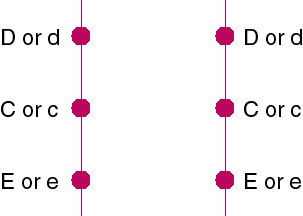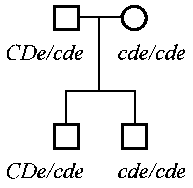
This theory is named after the two British workers who proposed it in the 1940's. Although too simplistic to explain this complex system, the theory is useful to explain routine inheritance of D, C, E, c, and e genes. The main tenets of the theory are as follows:
Rh inheritance is controlled by 3 closely linked loci on each chromosome of a homologous pair (Figure 5-1).


In the example shown in Figure 5-2, offspring can be CDe/cde or cde/cde. Even though the father has d , C and e genes, the Cde complex cannot be transmitted to offspring because crossing-over cannot occur.
Note: Although too simplistic to account for the polymorphism of the Rh system, the Fisher-Race theory is still used to determine Rh phenotypes and the nomenclature is used routinely. The term "d" indicates the absence of D; the d gene does not exist.

| Fisher-Race Theory |